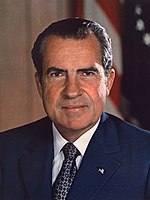1972_United_States_presidential_election_in_Florida
1972 United States presidential election in Florida
Election in Florida
The 1972 United States presidential election in Florida was held on November 7, 1972, as part of the concurrent United States presidential election. Florida voters chose seventeen electors, or representatives to the Electoral College, who voted for president and vice president. Incumbent Republican President Richard Nixon won the state over the Democratic nominee, South Dakota Senator George McGovern, by a landslide margin of 44.11% and over one million votes.
After having been among the strongest parts of the Democratic "Solid South" between 1892 and 1944 – except when vehement anti-Catholicism in the Panhandle and urban Republican support gave the state's electoral votes to Herbert Hoover in 1928 – Florida turned into a Republican-leaning state at the presidential level from 1948 due to the growth of a strongly business-oriented society in, and influx of conservative Northern retirees to, newly-developed South Florida following World War II.[1] Aided by this vote, the Republicans carried Florida in all three presidential elections from 1952 to 1960,[2] though North Florida remained Democratic-leaning.
The civil rights movement of the 1960s saw a dramatic change in the next two elections. The classically Deep Southern north of the state, affected by turmoil over school and university desegregation,[3] went powerfully to the staunchly conservative Republican Barry Goldwater in 1964 and then to the segregationist third-party candidacy of George Wallace in 1968. The southern urban areas that had supported the Republicans between 1948 and 1960, meanwhile, contained huge numbers of former Northern retirees hostile to Goldwater's proposed privatization of Social Security, and turned first to Lyndon Johnson before Nixon recaptured most of them for the Republicans in 1968.[4]
The 1972 Democratic presidential primary in Florida saw Wallace easily carry the state (including every county but highly urbanized Dade) in a ballot that also featured a referendum on court-ordered busing, in which more three-fourths of voters supported a constitutional ban on the practice.[5][6] McGovern and John Lindsay were supporters of busing who accused even their rivals Hubert Humphrey and Henry M. Jackson of being covert racists for their opposition thereto, while Wallace openly campaigned against it.[6] Wallace, the opponent most feared by Nixon, was paralyzed by an attempted assassination in May, and McGovern won the nomination from powerful support in the Midwestern and Pacific states. Once McGovern won the nomination, he offered Florida Governor Reubin Askew the vice-presidential slot, but Askew turned the position down.[7]
As of 2020, this is the last election in which Gadsden County voted for a Republican presidential candidate, and the only election in which a Republican won all of the state's counties.[8] 78% of white voters supported Nixon while 22% supported McGovern.[9][10]



